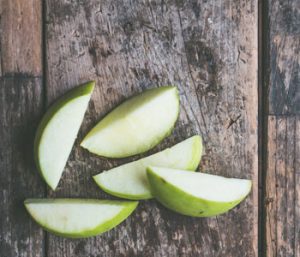Nothing says snacktime like a sudden craving for something crunchy. But why are we drawn to crunchy textures, especially when it comes to snacking?
It’s already shaping up to be a long, stressful day at the office. To get away from your exploding inbox and the eye strain of your computer screen, you head to the kitchen for a little break and, of course, a snack.
Let’s say your options today are chips, candy, or a nice bowl of grapes. You know you should be eating healthy, but you just can’t shake the craving for some crunchy goodness. This leads us to an incredibly important question: why on earth do humans love—and crave—crunchy snacks?
Maybe It’s All About Crunch
 Flavor isn’t everything, even if it’s what we tend to gravitate towards when choosing our next snack. But you may be unknowingly drawn to crispy, crunchy, and crackly foods simply for the sound. In fact, you might even be reaching for a bag of chips or popcorn right now just by thinking about those onomatopoeic words – words that suggest the sound that they describe.
Flavor isn’t everything, even if it’s what we tend to gravitate towards when choosing our next snack. But you may be unknowingly drawn to crispy, crunchy, and crackly foods simply for the sound. In fact, you might even be reaching for a bag of chips or popcorn right now just by thinking about those onomatopoeic words – words that suggest the sound that they describe.
The sound of your own chewing is conducted both via the air and through the bones in your jaw and ear; this gives different levels of crunch a distinctive sound. We then use this information to make interpretations about the freshness of what we are eating. Researchers out of the University of Oxford found the sound of chips entirely change our perception of them, even if they’re a chip from the same bag eaten just seconds apart. You wouldn’t think the crunch is that big of a deal, but the data showed just how important it was to food perception. Artificially increasing the crunch volume while eating chips increased their subject’s perception of freshness and crispiness. Lowering the volume, on the other hand, lowered the participant’s delight in the chips.
There’s also the “Crunch Effect.” Even if you don’t fully stop to appreciate a nice crunch, focusing on the sound of your own eating can help reduce how much you eat. So you don’t need to completely cut out snacking to cut back, just practice mindful crunching.
We rely on our hearing to enjoy and learn from the world around us, so why should it be any different when it comes to eating? Although the science of crunchy cravings is still in its infancy, nutritionists and food scientists alike are starting to realize the importance of sound in culinary experiences.
This includes negative experiences. For example, someone in your office might absolutely loathe the sound of crunching. There’s a word for that: misophonia. It means you hate particular sounds like clicking pens or chewing. While it typically doesn’t bother a person with misophonia to eat crunchy foods themselves, just being around the noise can be a skin-crawling experience.
Could It Be… the Feeling?
Your go-to snack can say a lot about what food scientists call your “preferred mouth behavior.” That’s just a fancy way of saying your munching preferences. There are four distinct categories: Crunchers, Chewers, Suckers, and Smooshers. Your enjoyment of crunchy foods might be because you’re a Cruncher! (Shocking, we know.)
Crunchers prefer foods like crisp apples, raw vegetables, and ice cream with crunchy pieces inside. That’s not to say you don’t occasionally enjoy a Smoosher’s melty chocolate or a Sucker’s hard candy, just that you tend to prefer the crunch when you’re chowing down.
It might also be your brain responding positively to the crispiness of your foods. One theory of why we like crunchy snacks is our early ancestors relied heavily on crunchy insects and plant stalks for nutrition. These habits—deep, deep down in your brain—may be some ancient instinct driving you to seek out crunchy food.
Or Maybe It’s All About Your Feelings?
Nothing takes a bite out of stress like a little snacking. Emotional eating, or using food as a way to manage your emotions, is pretty common. Cravings for salty, crunchy snacks are often  associated with boredom. It’s no surprise we turn to food when we’re bored or upset; after all, it takes your mind off your stressors, fills your tummy, and potentially releases jaw tension.
associated with boredom. It’s no surprise we turn to food when we’re bored or upset; after all, it takes your mind off your stressors, fills your tummy, and potentially releases jaw tension.
That’s right, extremely crunchy foods may help alleviate anxiety and keep you from clenching your jaw. (Unless you have jaw pain or TMJ. In that case, crunchy foods might worsen the problem, so watch out.)
Crunchy foods also have the benefit of taking longer to chew, which helps slow you down and prolong your eating satisfaction. This means you might even eat less if you’re paying attention. Your stomach takes a while to tell your brain it’s satiated, so eating slowly and mindfully helps give that signal time to make its way up to your brain.
Your upbringing might also be a reason crunchy foods are so appealing. If you associate crunchy foods with childhood rewards, treats, or even happy memories, you’re more likely to reach for those snacks later in life.
Is It Just the Flavor?
Unless you’re biting into a raw veggie, crispy food is usually roasted, seared, or fried. Cooking food is often seen as a key trait of humanity, but it’s also responsible for undeniably delicious flavors from the Maillard reaction. This is when the sugars and proteins of food are transformed through a series of chemical reactions caused by heat.
It’s where we get scrumptious browning on steaks and potatoes under high heat. Depending on what you’re cooking, you get tasty butyric acid—think the smell of melting butter—or even the caramelization of sugars that give you sweet and nutty flavors.
Crunchy snacks, whether they’re roasted or fried, offer these delectable flavor molecules along with a satisfying sound and stomach-filling carbohydrates, salts, and fats. (Remember: fats in moderation aren’t bad for you, especially if they’re a healthier type of fat.)
Embrace the Crunch: It’s Not Going Anywhere
Whatever the underlying reason, there’s an undeniable truth to crunchy snacks: humans love them. Another inescapable truth is snack producers know it too, which is why your grocery store has shelf after shelf of crispy, crunchy treats.
But eating healthy doesn’t mean cutting out that satisfying crunch—and we don’t mean just switching to crisp fruits and veggies. Look for snacks without hydrogenated oils, MSGs, GMOs, corn syrups, high sugar content, and artificial flavors, colors, and sweeteners that still satisfy your sonic senses. You’d be surprised how many healthy (and delicious) alternatives are out there!
If you’re not an Oh My Green customer yet, get started now and make the upgrade to healthy snacking today.